Improving Surface Wear Resistance of Polyimide by Inserting KH550 Grafted GO
Abstract
:1. Introduction
2. Model Establishment and Simulation Process
3. Results and Discussion
3.1. Mechanical Properties of PI Composites
3.2. Tribological Properties of PI Composites
4. Conclusions
- Adding graphene based nanomaterials can improve the mechanical properties of PI composites, in which K5-GO exhibits the best effect, increasing the Young’s modulus to 6.87 GPa and the shear modulus to 1.8 GPa, which are 94% and 16% higher than pure PI. Besides, the enhancement mechanism was revealed by analyzing the interaction energy between the modifiers and PI molecular. The higher the interaction energy, the stronger the adsorption effect, and resulting in the the better the mechanical performance.
- Compared with pure PI, the surface modified PI composites have smaller friction coefficients, among which K5-GO can reduce the friction coefficient to one-third of the original value. The K5-GO/PI also shows the smallest shear deformation. By analyzing the interfacial interaction energy between PI and the Cu layer, it was found that the interfacial interaction between PI and the friction pair would decrease after the addition of modifiers, further confirming the enhanced effect of modifiers on the PI matrix. These results are helpful for a deeper understanding of the structure and properties of polymer-based composites, and provide important references for the design and manufacture of high-performance polymer composites.
Author Contributions
Funding
Institutional Review Board Statement
Data Availability Statement
Conflicts of Interest
References
- Takasaki, M.; Osakabe, N.; Kurosawa, M.K.; Higuchi, T. Miniaturization of surface acoustic wave linear motor. In Proceedings of the 1998 IEEE Ultrasonics Symposium, Sendai, Japan, 5–8 October 1998; pp. 679–682. [Google Scholar]
- Behera, B.; Nemade, H.B. Investigating translational motion of a dual friction-drive surface acoustic wave motor through modeling and finite element simulation. Simul. Trans. Soc. Model. Simul. Int. 2019, 95, 117–125. [Google Scholar] [CrossRef]
- Wang, X.Z.; Zhang, J. Characteristic analysis and experimental research on vibrator of square-ring type liner standing wave motor. In Proceedings of the 2021 International Conference on Machine Learning and Intelligent Systems Engineering (MLISE), Chongqing, China, 9–11 July 2021; pp. 253–257. [Google Scholar]
- Pan, C.; Feng, A.; Wu, J.; Hu, M.; Shi, C.; Xia, H. Transient Motion Analysis of a Piezoelectric Motor Based on Resonant-type Impact Drive Mechanism. In Proceedings of the 2021 International Conference on Sensing, Measurement & Data Analytics in the era of Artificial Intelligence (ICSMD), Nanjing, China, 21–23 October 2021; pp. 1–5. [Google Scholar]
- Li, B.; Lv, W.; Zhao, N.; Li, J.; Peng, D.; Yu, Y.; Mu, Q.; Zhang, F.; Wang, F.; Wang, Z. Research development of polyimide based solid lubricant. N. Chem. Mater. 2017, 45, 8–10. [Google Scholar]
- Uchino, K.; Koc, B.; Dong, S. Compact ultrasonic rotary motors. Ferroelectrics 2001, 257, 3–12. [Google Scholar] [CrossRef]
- Sanchez-Margallo, J.A.; Tas, L.; Moelker, A.; van den Dobbelsteen, J.J.; Sanchez-Margallo, F.M.; Lango, T.; van Walsum, T.; van de Berg, N.J. Block-matching-based registration to evaluate ultrasound visibility of percutaneous needles in liver-mimicking phantoms. Med. Phys. 2021, 48, 7602–7612. [Google Scholar] [CrossRef]
- Kitoh, M.; Honda, Y. Preparation and tribological properties of sputtered polyimide film. Thin Solid Film. 1995, 271, 92–95. [Google Scholar] [CrossRef]
- Feger, C.; Franke, H. Polyimides Fundamentals and Applications; CRC Press: Boca Raton, FL, USA, 2018; pp. 759–814. [Google Scholar]
- Lau, K.S. Handbook of Thermoset Plastics; Elsevier: Amsterdam, The Netherlands, 2014; pp. 297–424. [Google Scholar]
- Ree, M. High performance polyimides for applications in microelectronics and flat panel displays. Macromol. Res. 2006, 14, 1–33. [Google Scholar] [CrossRef]
- Wu, Z.Y.; He, J.J.; Yang, H.X.; Yang, S.Y. Progress in Aromatic Polyimide Films for Electronic Applications: Preparation, Structure and Properties. Polymers 2022, 14, 1269. [Google Scholar] [CrossRef]
- Yu, Y.H.; Zhao, G.; Song, J.F.; Ding, Q.J. Mechanical and Tribological Properties of Polyimide Composites for Reducing Weight of Ultrasonic Motors. Key Eng. Mater. 2019, 799, 65–70. [Google Scholar] [CrossRef]
- Bahadur, S. The development of transfer layers and their role in polymer tribology. Wear 2000, 245, 92–99. [Google Scholar] [CrossRef]
- Li, S.; Yang, R.; Wang, T.M.; Zhang, X.R.; Wang, Q.H. Surface textured polyimide composites for improving conversion efficiency of ultrasonic motor. Tribol. Int. 2020, 152, 106489. [Google Scholar] [CrossRef]
- Perez-Guardiola, A.; Perez-Jimenez, A.J.; Sancho-Gracia, J.C. Studying physisorption processes and molecular friction of cycloparaphenylene molecules on graphene nano-sized flakes: Role of pi center dot center dot center dot pi and CH center dot center dot center dot pi interactions. Mol. Syst. Des. Eng. 2017, 2, 253–262. [Google Scholar] [CrossRef] [Green Version]
- Bahadur, S.; Fu, Q.; Gong, D. The effect of reinforcement and the synergism between cus and carbon-fiber on the wear of nylon. Wear 1994, 178, 123–130. [Google Scholar] [CrossRef]
- Bijwe, J.; Indumathi, J.; Rajesh, J.J.; Fahim, M. Friction and wear behavior of polyetherimide composites in various wear modes. Wear 2001, 249, 715–726. [Google Scholar] [CrossRef]
- Friedrich, K.; Lu, Z.; Hager, A.M. Recent advances in polymer composites’ tribology. Wear 1995, 190, 139–144. [Google Scholar] [CrossRef]
- Xian, G.J.; Zhang, Z. Sliding wear of polyetherimide matrix composites I. Influence of short carbon fibre reinforcement. Wear 2005, 258, 776–782. [Google Scholar] [CrossRef]
- Yan, Y.F.; Meng, Z.J.; Xin, X.C.; Liu, H.; Yan, F.Y. Tribological Behavior and Thermal Stability of Thermoplastic Polyimide/Poly (Ether Ether Ketone) Blends at Elevated Temperature. J. Macromol. Sci. Part B Phys. 2020, 60, 175–189. [Google Scholar] [CrossRef]
- Chan, J.X.; Wong, J.F.; Petru, M.; Hassan, A.; Nirmal, U.; Othman, N.; Ilyas, R.A. Effect of Nanofillers on Tribological Properties of Polymer Nanocomposites: A Review on Recent Development. Polymers 2021, 13, 2687. [Google Scholar] [CrossRef]
- Breki, A.D.; Vasilyeva, E.S.; Tolochko, O.V.; Didenko, A.L.; Nosonovsky, M. Frictional Properties of a Nanocomposite Material With a Linear Polyimide Matrix and Tungsten Diselinide Nanoparticle Reinforcement. J. Tribol. Trans. Asme 2019, 141, 082002. [Google Scholar] [CrossRef]
- Cai, H.; Yan, F.; Xue, Q. Tribological behavior and SEM investigation of the polyimide/SiO_2 nanocomposites. J. Chin. Electron. Microsc. Soc. 2003, 22, 420–425. [Google Scholar]
- Zhang, X.R.; Pei, X.Q.; Wang, Q.H. Friction and wear studies of polyimide composites filled with short carbon fibers and graphite and micro SiO2. Mater. Des. 2009, 30, 4414–4420. [Google Scholar] [CrossRef]
- Panin, S.V.; Luo, J.K.; Buslovich, D.G.; Alexenko, V.O.; Kornienko, L.A.; Bochkareva, S.A.; Byakov, A.V. Experimental-FEM Study on Effect of Tribological Load Conditions on Wear Resistance of Three-Component High-Strength Solid-Lubricant PI-Based Composites. Polymers 2021, 13, 2837. [Google Scholar] [CrossRef] [PubMed]
- Wu, J.; Kou, Z.M.; Cui, G.J. The tribological properties of carbon fiber reinforced polyimide matrix composites under distilled water condition. Ind. Lubr. Tribol. 2016, 68, 212–219. [Google Scholar] [CrossRef]
- Li, X.Q.; Jia, X.H.; Xiao, Q.F.; Li, Y.; Wang, S.Z.; Yang, J.; Song, H.J.; Zhang, Z.Z. CuO nanowires uniformly grown on carbon cloth to improve mechanical and tribological properties of polyimide composites. Mater. Chem. Phys. 2022, 281, 12852. [Google Scholar] [CrossRef]
- Cai, H.; Yan, F.Y.; Xue, Q.J. Investigation of tribological properties of polyimide/carbon nanotube nanocomposites. Mater. Sci. Eng. a-Struct. Mater. Prop. Microstruct. Process. 2004, 364, 94–100. [Google Scholar] [CrossRef]
- Chen, B.B.; Wang, J.Z.; Liu, N.; Yan, F.Y. Synergism of several carbon series additions on the microstructures and tribological behaviors of polyimide-based composites under sea water lubrication. Mater. Des. 2014, 63, 325–332. [Google Scholar] [CrossRef]
- Sekiguchi, I.; Takumi, K.; Naitoh, K.; Saitoh, T.; Watanabe, Y. On the effects of fillers upon the tribological properties of thermosetting polyimide. Res. Rep. Kogakuin Univ. 1992, 4, 804–810. [Google Scholar]
- Song, Y.-J.; Huang, L.-J.; Zhu, P.; Wang, X.-D.; Huang, P. Friction and Wear of Coupling Agent Treated Glass Fiber Modified Polyimide Composites. J. Mater. Eng. 2009, 2, 58–62. [Google Scholar]
- Shan, F.; Yu, Z.; Luo, L.; Zhang, Y. Study on surface modification of nano-alumina by silane coupling agent KH550. N. Chem. Mater. 2013, 41, 169. [Google Scholar]
- Li, N.; Zhang, X.; Jin, X.; Xu, C.; Zhuo, G. Effects of Adding KH550 on Micromorphology and Property of Waste Paper Fiber Reinforced Polylactic Acid Composite. Mater. Mech. Eng. 2019, 43, 5. [Google Scholar]
- Yin, Y.H.; Song, J.F.; Zhao, G.; Ding, Q.J. Improving the high temperature tribology of polyimide by molecular structure design and grafting POSS. Polym. Adv. Technol. 2022, 33, 886–896. [Google Scholar] [CrossRef]
- Li, Y.L.; Wang, S.J.; Wang, Q.; Xing, M. Enhancement of fracture properties of polymer composites reinforced by carbon nanotubes: A molecular dynamics study. Carbon 2018, 129, 504–509. [Google Scholar] [CrossRef]
- Min, C.Y.; Shen, C.; Zeng, M.; Nie, P.; Song, H.J.; Li, S.J. Influence of graphene oxide as filler on tribological behaviors of polyimide/graphene oxide nanocomposites under seawater lubrication. Mon. Fur Chem. 2017, 148, 1301–1309. [Google Scholar] [CrossRef]
- Wang, X.L.; Huang, W.J. Presented at 3rd International Conference on Chemical Engineering and Advanced Materials (CEAM 2013), Guangzhou, China, 6–7 July 2013; Volume 785–786, pp. 138–144.
- Yin, Y.; Lei, H.; Song, J.; Zhao, G.; Ding, Q. Molecular Dynamics Simulation on the Tribological Properties of Polytetrafluoroethylene Reinforced with Modified Graphene. Tribology 2022, 42, 598–608. [Google Scholar]
- Hu, Y.Z.; Ma, T.B.; Wang, H. Energy dissipation in atomic-scale friction. Friction 2013, 1, 24–40. [Google Scholar] [CrossRef] [Green Version]
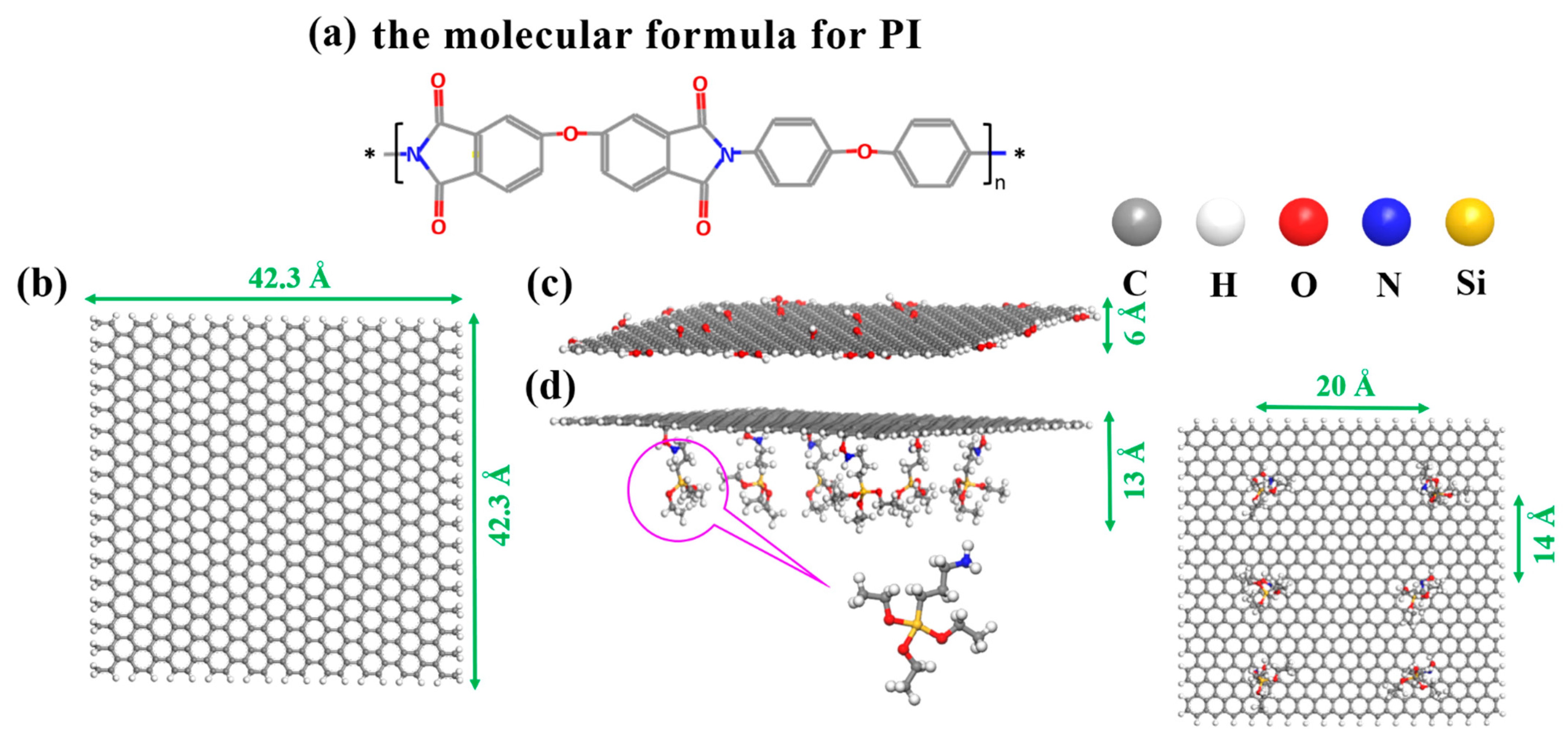
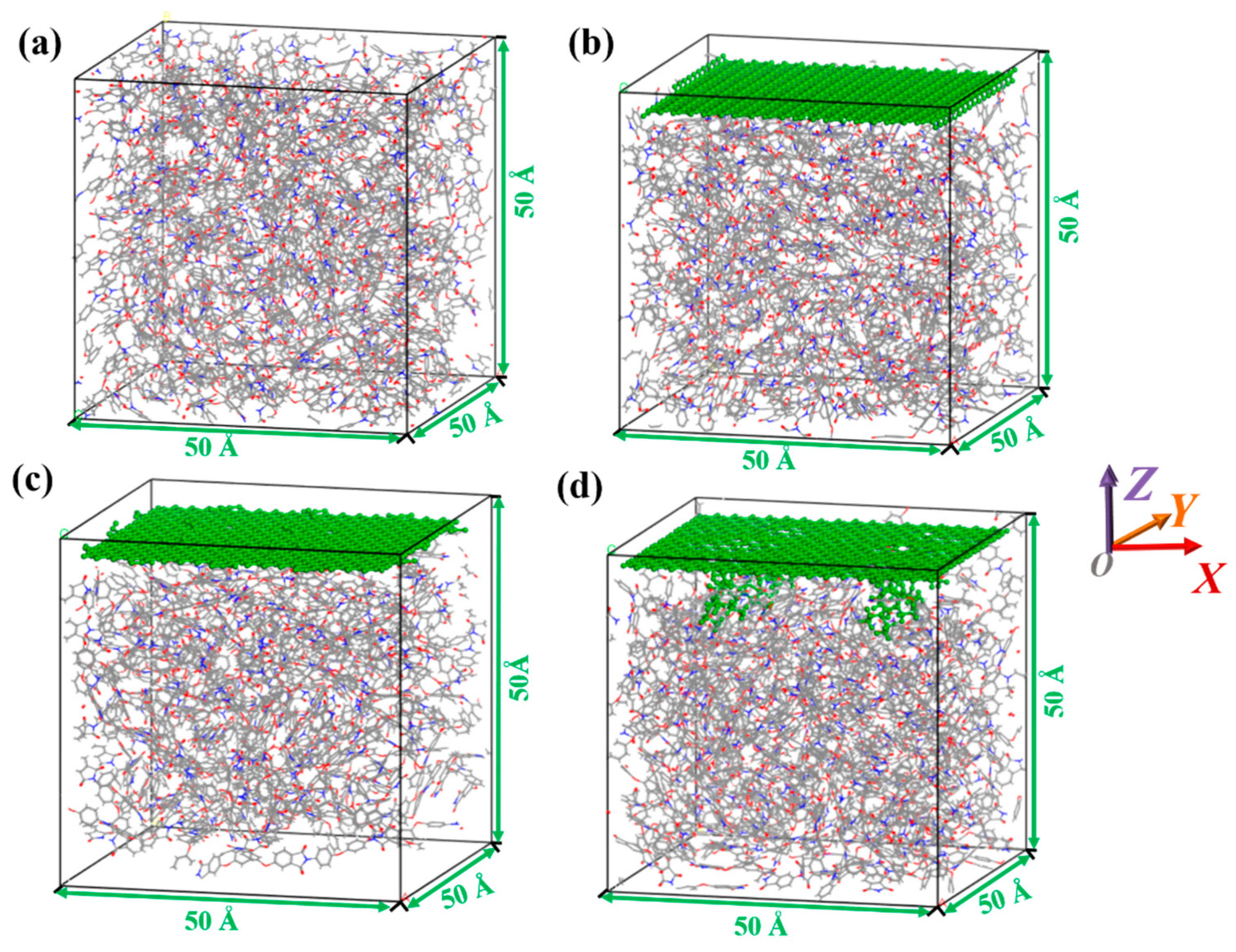
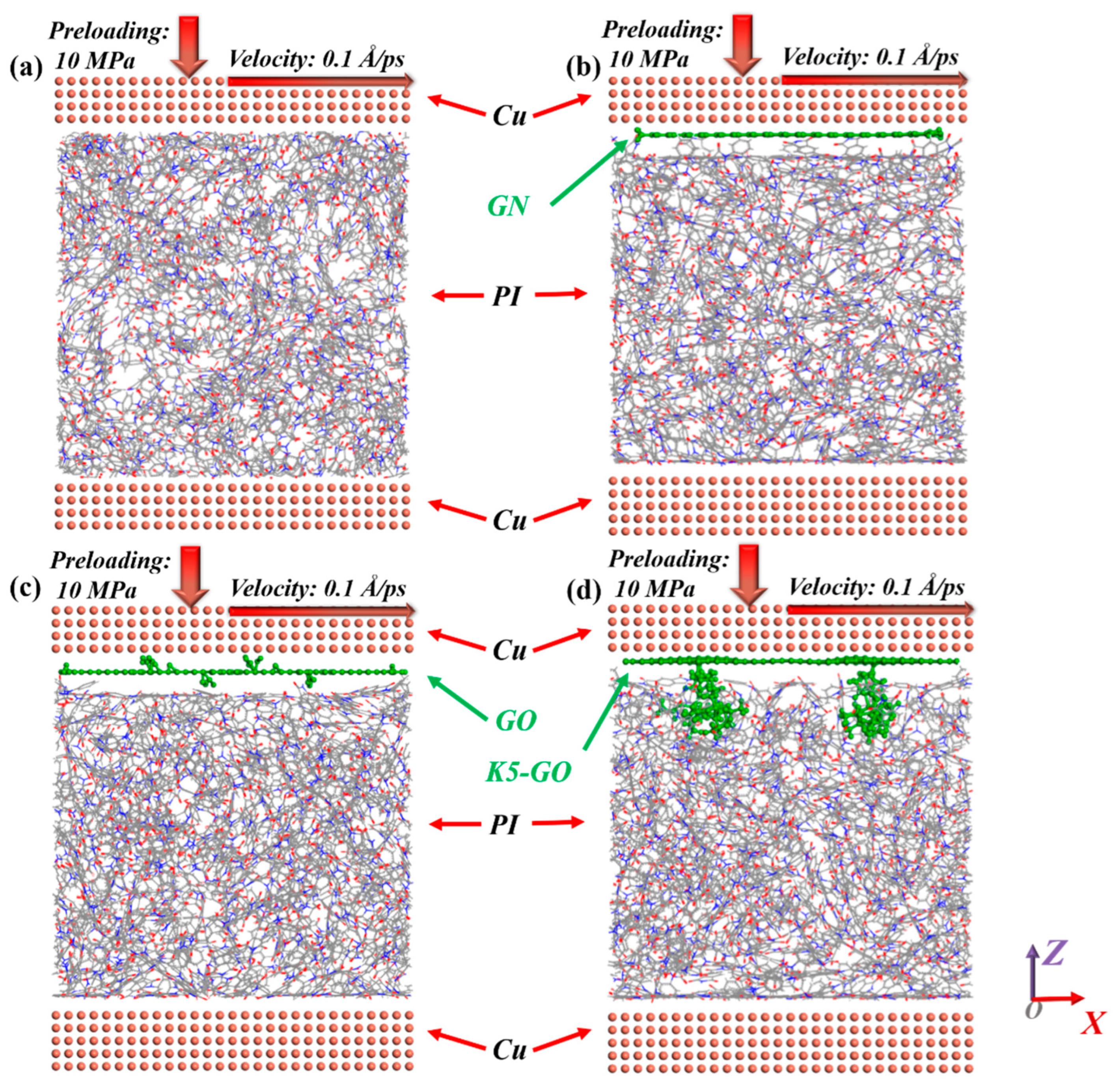
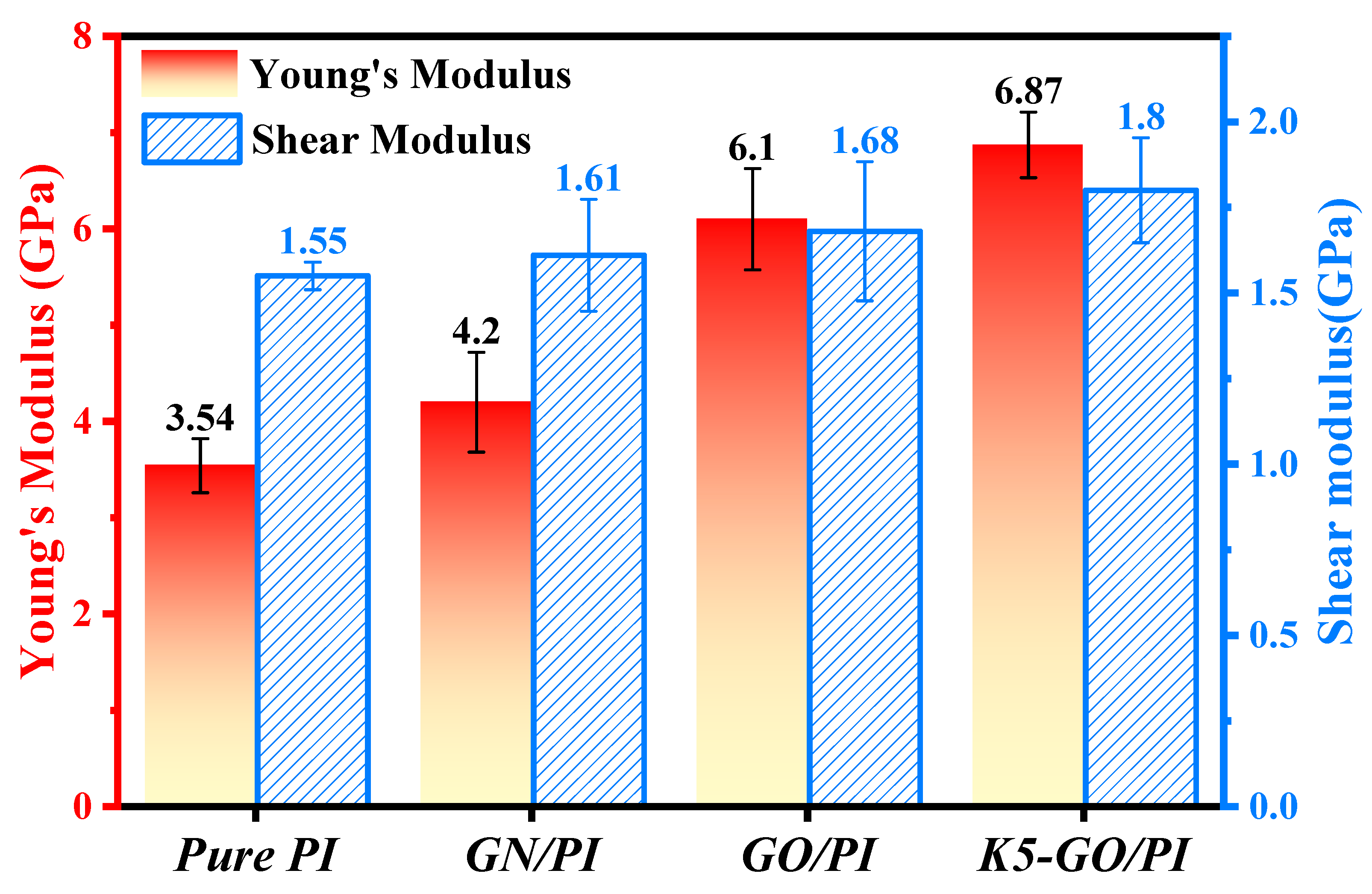
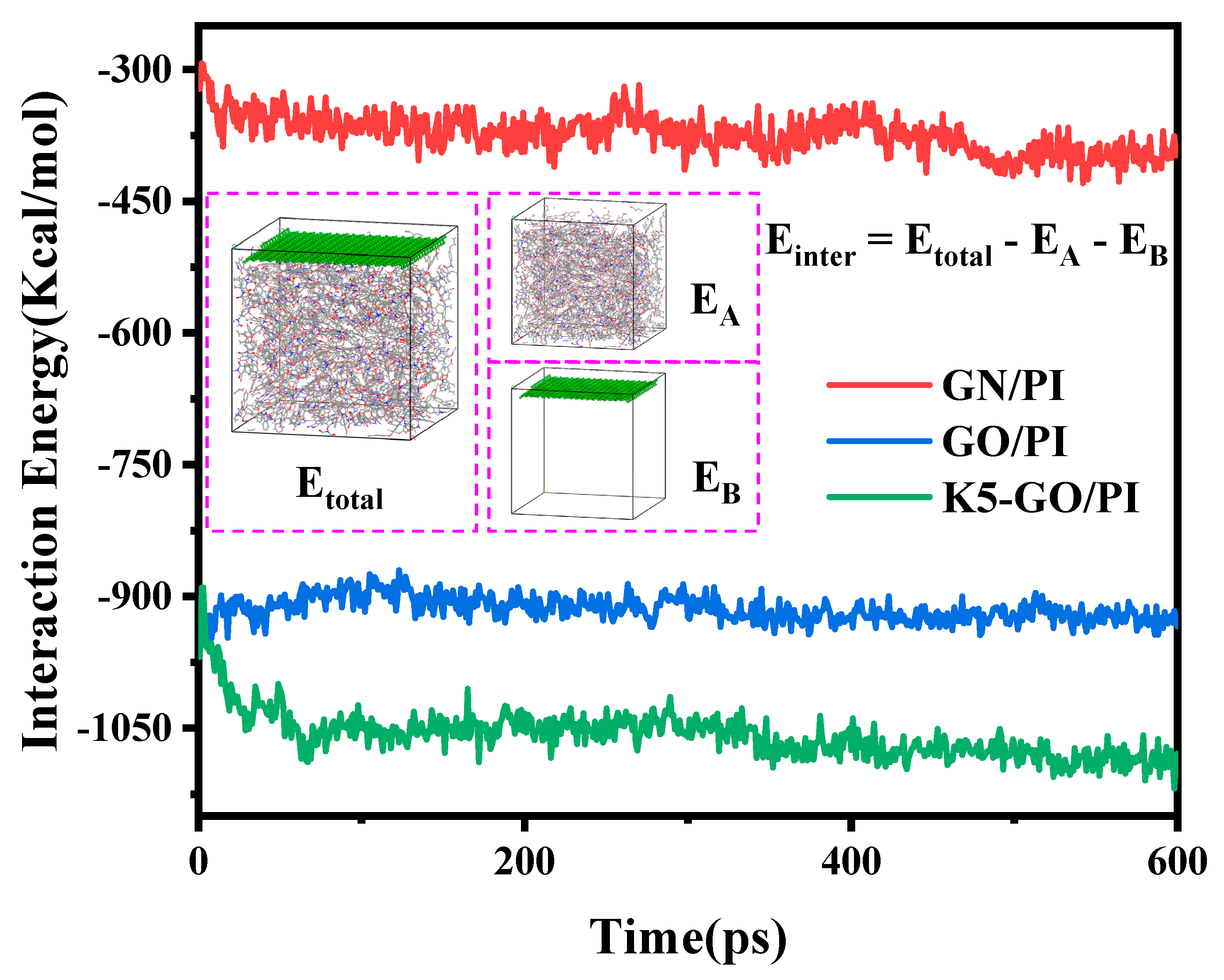
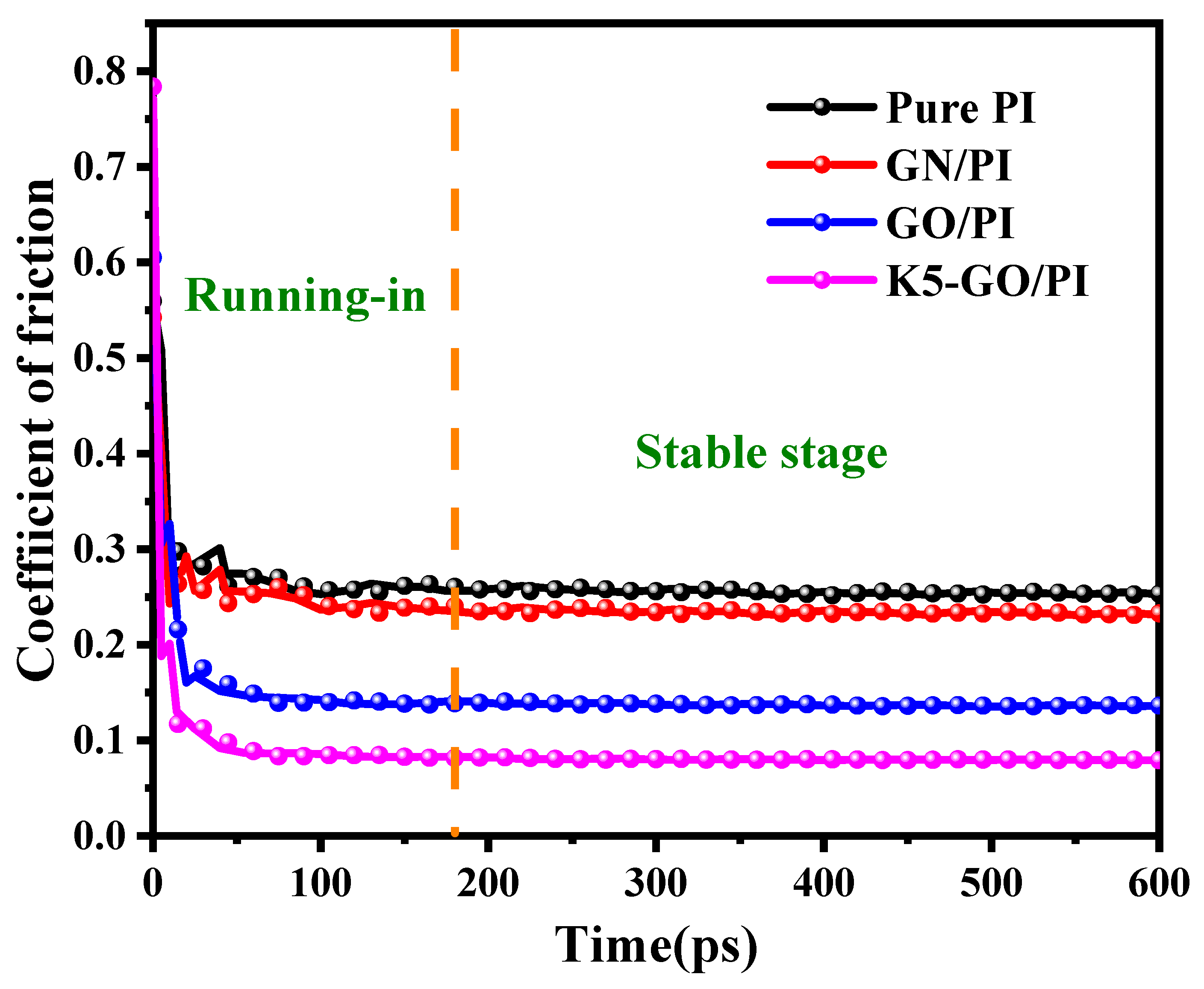

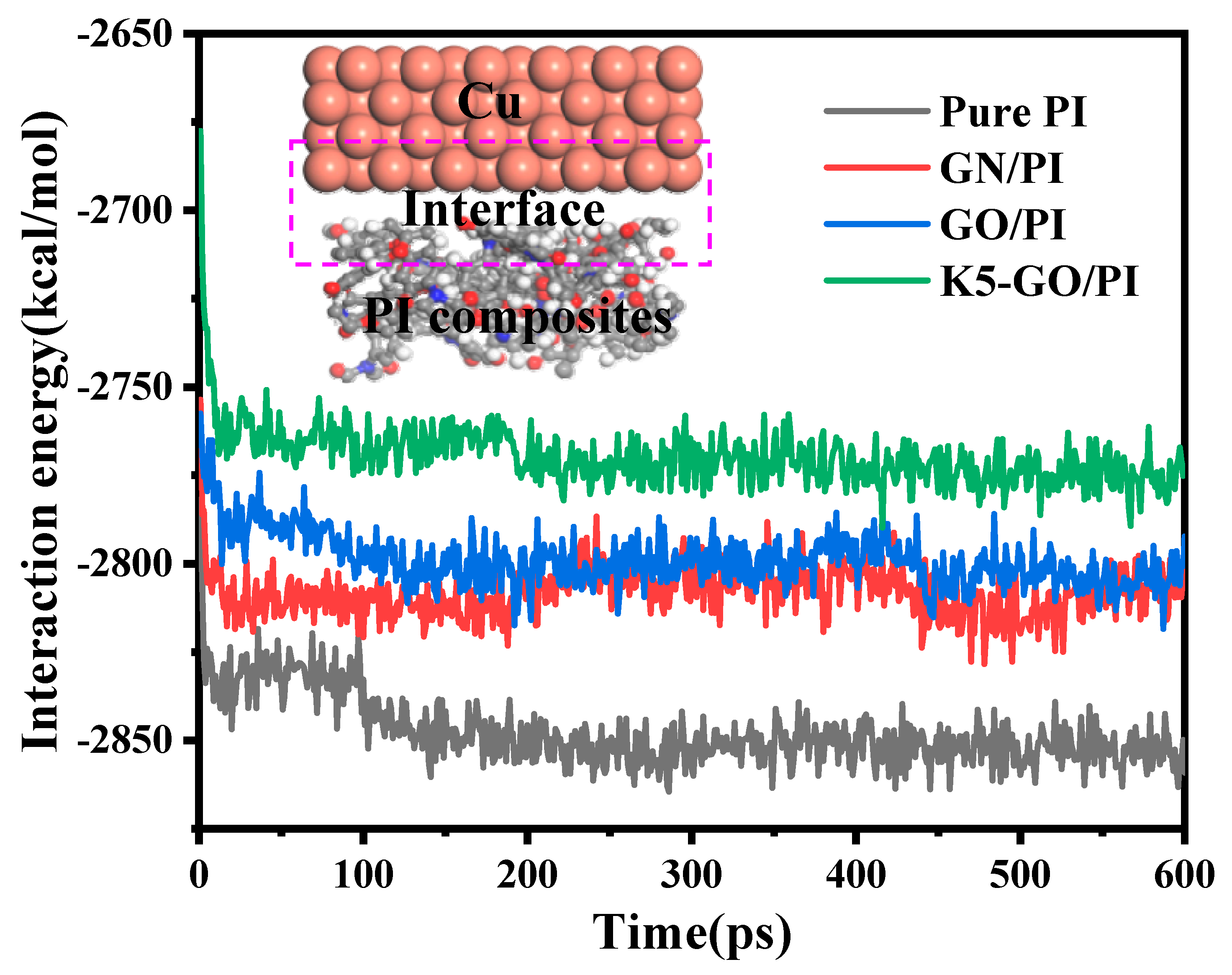
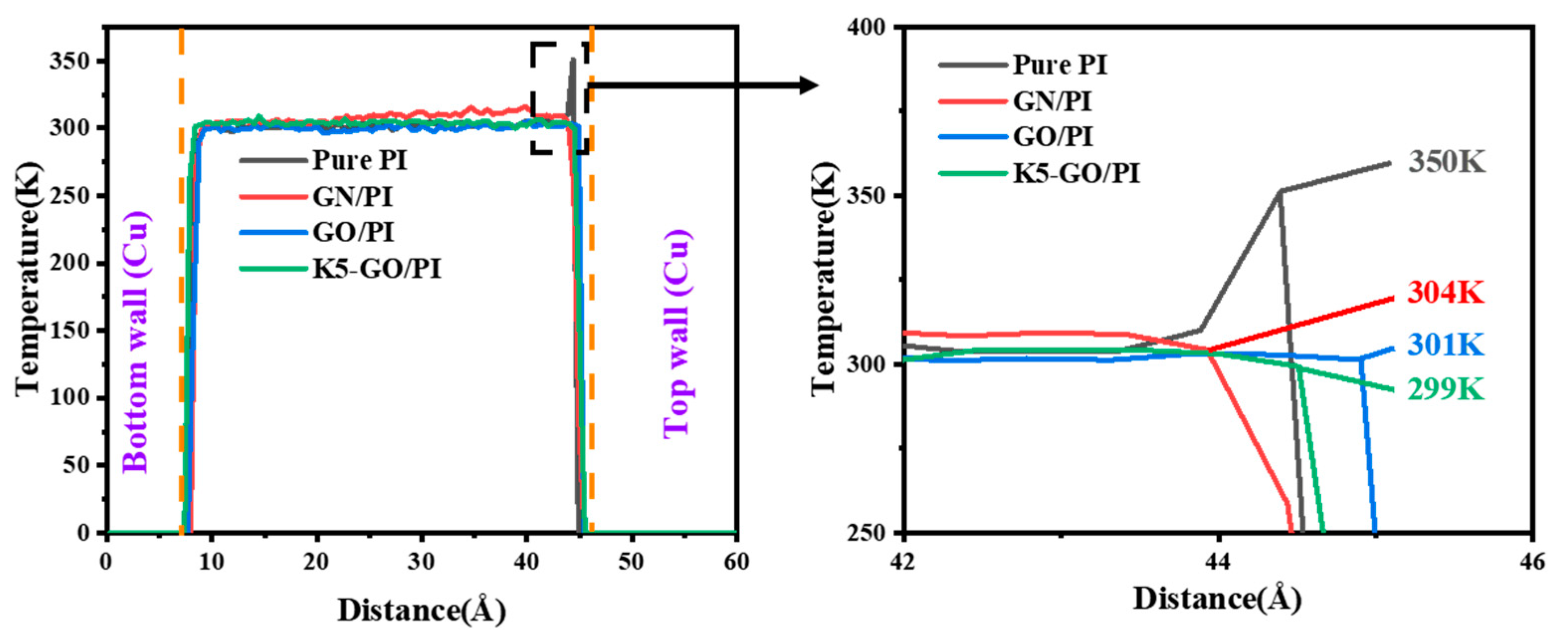
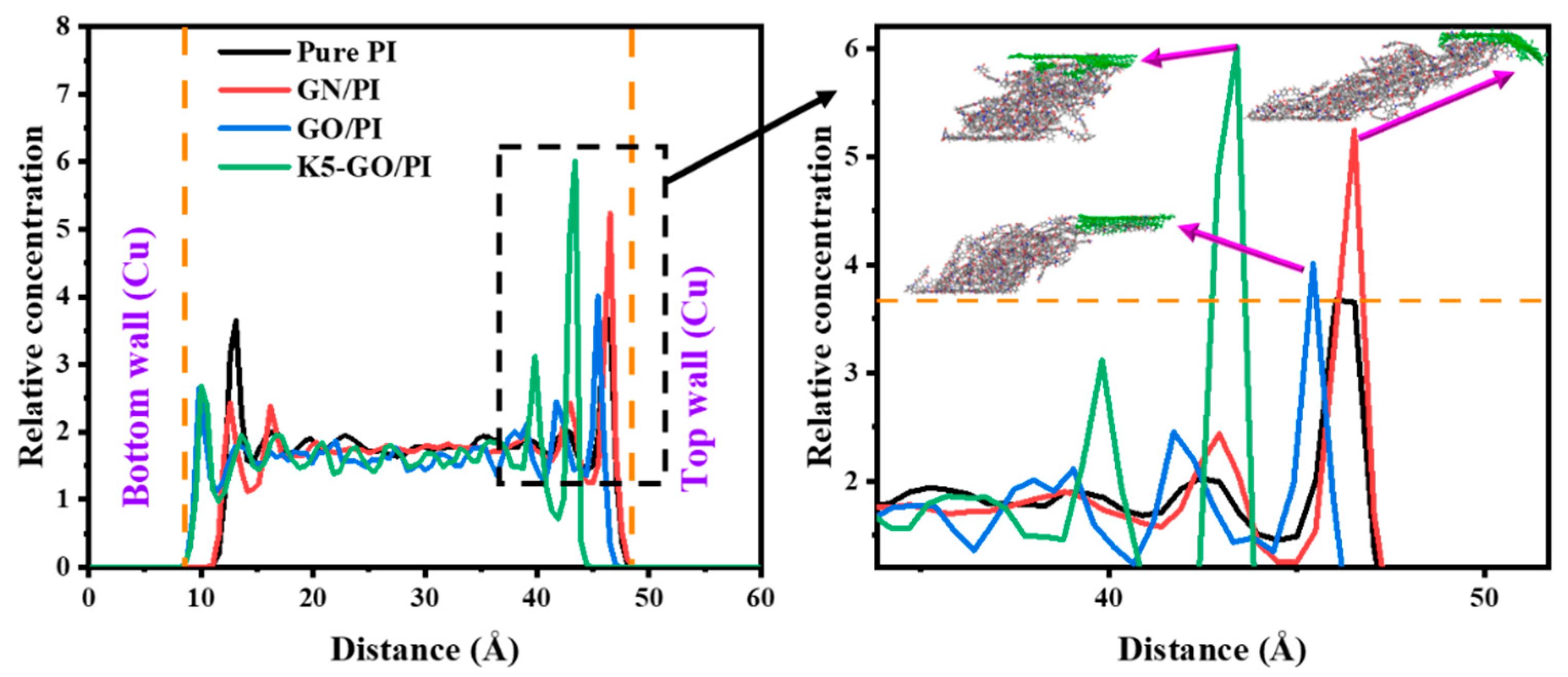
| Optimization Process | Algorithm | Convergence Criterion | Temperature | Time |
|---|---|---|---|---|
| Geometry optimization | Smart | 1 × 10−4 kcal/mol 0.005 kcal/mol/Å | / | |
| Anneal | Nose thermostat | / | 300–600 K | |
| NVT | Nose thermostat | / | 300 K | 300 ps |
| NPT | Berendsen barostat | / | 300 K | 600 ps |
Disclaimer/Publisher’s Note: The statements, opinions and data contained in all publications are solely those of the individual author(s) and contributor(s) and not of MDPI and/or the editor(s). MDPI and/or the editor(s) disclaim responsibility for any injury to people or property resulting from any ideas, methods, instructions or products referred to in the content. |
© 2023 by the authors. Licensee MDPI, Basel, Switzerland. This article is an open access article distributed under the terms and conditions of the Creative Commons Attribution (CC BY) license (https://creativecommons.org/licenses/by/4.0/).
Share and Cite
Liu, C.; Song, J.; Zhao, G.; Ding, Q. Improving Surface Wear Resistance of Polyimide by Inserting KH550 Grafted GO. Polymers 2023, 15, 2577. https://doi.org/10.3390/polym15112577
Liu C, Song J, Zhao G, Ding Q. Improving Surface Wear Resistance of Polyimide by Inserting KH550 Grafted GO. Polymers. 2023; 15(11):2577. https://doi.org/10.3390/polym15112577
Chicago/Turabian StyleLiu, Chen, Jingfu Song, Gai Zhao, and Qingjun Ding. 2023. "Improving Surface Wear Resistance of Polyimide by Inserting KH550 Grafted GO" Polymers 15, no. 11: 2577. https://doi.org/10.3390/polym15112577
APA StyleLiu, C., Song, J., Zhao, G., & Ding, Q. (2023). Improving Surface Wear Resistance of Polyimide by Inserting KH550 Grafted GO. Polymers, 15(11), 2577. https://doi.org/10.3390/polym15112577







